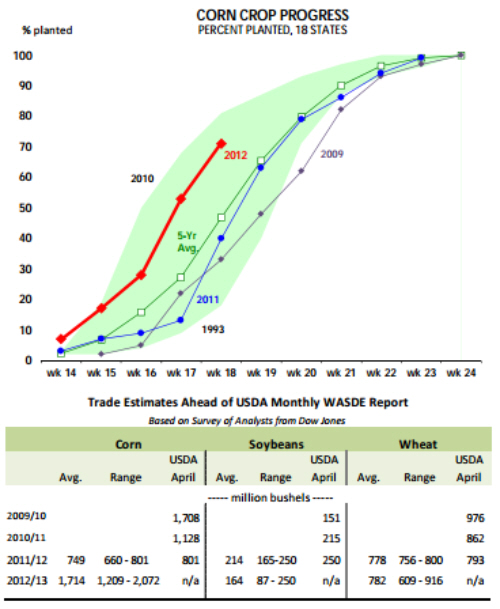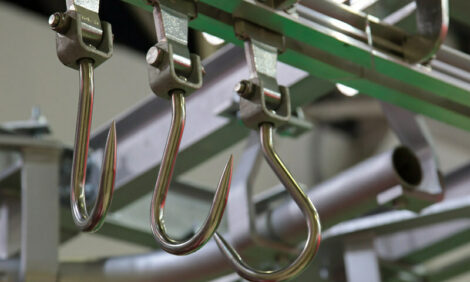



CME: Corn Market Remains Fluid
US - On Thursday, May 10 (7.30 CST) USDA will release its latest production estimates for US and world agricultural commodities. The situation in the corn market remains particularly fluid, with the market still in a demand rationing mode for old crop corn, write Steve Meyer and Len Steiner. July corn futures in overnight trading
were $6.2725/bu., a premium of $1.02/bu. over December
futures. Old corn crop stocks remain tight and some market
participants are pegging ending stocks for 2011-12 as low as 660
million bu. Strong export sales and higher feed use will likely
continue to pressure old corn crop prices into July and maintain
the premiums to Dec corn. As for the new crop, there is broad
expectation that farmers will likely produce the largest corn crop
on record, enough to bring carryover stocks to more normal levels. USDA will publish its first estimate of US corn supplies for
2012/13, an estimate based on the expectation that planted acres
will be over 96 million bushels per acre and that yields will recover from two dismal years and be close to the 164 bu./acre
trend yield for 1990-2010. This is basically the scenario outlined
by USDA in their February outlook report and there has been
little in recent months that could change this view.
Indeed,
farmers have been able to get the crop in the ground early and so
far planting progress is running well ahead of both year ago and
the five year average pace. The latest USDA crop progress report indicated that as of May 6 US farmers had planted over
71% of the corn crop. For the same week last year farmers
had planted just 40% of the crop and the five year average pace
is at 47%. The Eastern Corn Belt, which was hit particularly
hard last year, appears to be in excellent shape this time around.
Indiana has planted 84% of the crop, compared to just 3% last
year while Illinois has planted 89% of the crop compared to 27%
a year ago. Impressively, about 64% of the Illinois crop and 50%
of the Indiana crop is already emerged. Early emergence does
not guarantee great yields but it lowers the probability that the
crop will be exposed to late July heat during its pollination
phase. Predictably, market participants polled ahead of the
USDA report indicated they expect corn ending stocks to recover.
The chart to the right outlines market expectations for corn,
beans and wheat. On average, corn ending stocks for 2012/13 are
expected to be 1.714 billion bushels, compared to an average of
749 million bushels in 2011/12. The last time total ending stocks
were anywhere close to these levels was in 2009-10, when ending
stocks were 1.708 billion bushels. That year, the average farm price was $3.55 bushel. Keep in mind, however, that corn use for
2012/13 is expected to be larger than in 2009/10 (higher exports
and more ethanol) so it is more important to keep an eye on the
stocks/use (S/U) ratio, which takes into account the growth in
demand. The S/U ratio in 2009/10 was 13.1%. In the following
two years, we have seen the stocks to use ratio decline to 8.6% in
2010-11 and ~6% in 2011-12. We would expect that ending
stocks of about 1.7 billion bushels would correspond to a S/U ratio
of about 12.6%. In 2007-08 we had a similar S/U ratio and farm
prices were $4.20/bushel. Current supply estimates indicate
that corn could trade below $5/bushel next year but futures will
continue to price in summer weather risk, at least until early
August. So far, however, livestock and poultry producers can
look forward to a much improved feed outlook.









